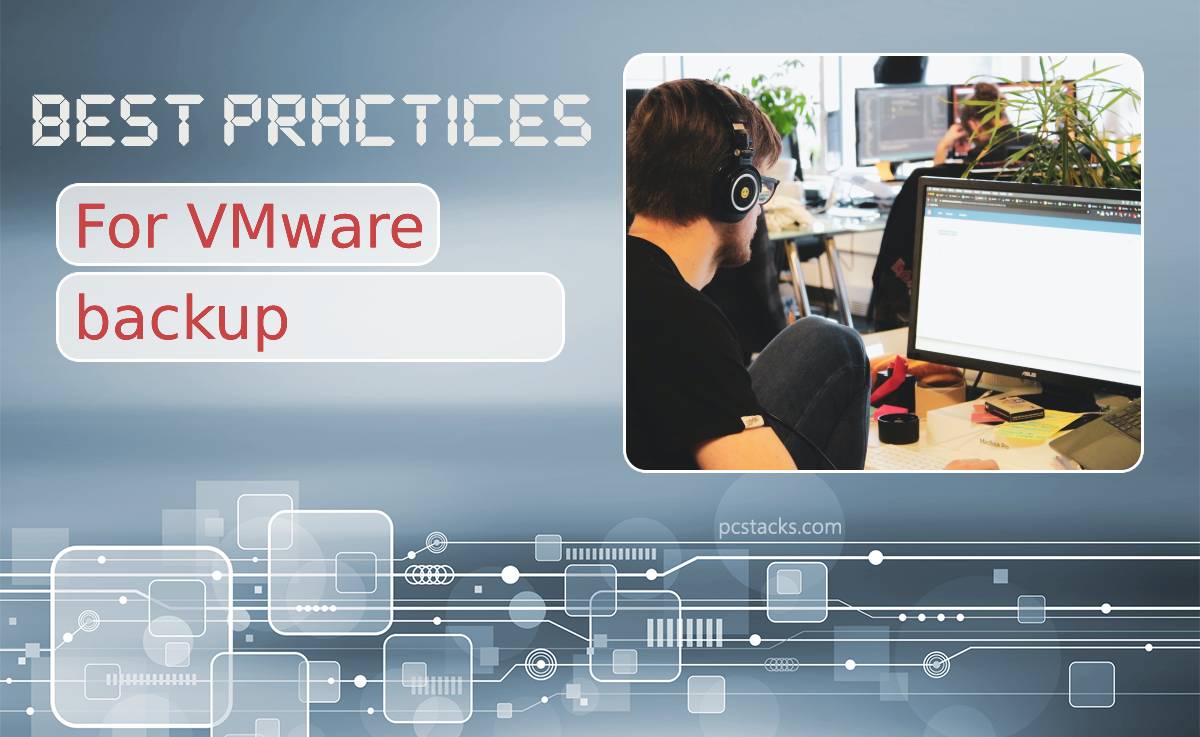Backups are an essential part of virtual data protection. Nowadays, tens of thousands of businesses run VMware environments around the clock. They all require continuous data protection for virtualized infrastructures.
To deliver efficient backups, let’s review the VMware backup best practices and see what works best when backing up a VMware vSphere VM. This post discusses 11 backup strategies that can help you refine your VMware backup process.
Table of Contents
1. Backing Up Data Regularly

There is a misconception that there is no need to back up virtual machines (VMs) because they are not physical machines but are located on top of the virtualization layer instead. However, this assumption is not entirely true. Virtual machines and all of the data that resides on them can be affected by ransomware attacks, disasters, or system failure. These disruptive events can cause permanent data loss, and that’s where backups come to save the day.
The good news is that a VMware backup solution can provide state-of-the-art protection for vCenter-managed and standalone ESXi workloads. A modern agile VMware backup solution can bring vSphere data protection to the next level by simplifying backup performance and providing instant data recovery options.
2. Backing Up at the Virtualization Level
Another faulty thought is that guest OS backups are more affordable. Therefore, some businesses implement guest-level instead of host-level backups to save costs. Such an approach made sense in the past because guest OS backups were more affordable than host-level backups for businesses with smaller VMs. However, host-level backups are now equally cheap, and there is no need to use guest OS backups to save costs.
Now let’s take a brief look at the difference between a guest OS and a host OS backup. Guest-OS backup requires an agent to be installed on the OS of every VM. This agent copies full or partial data during a backup by interacting with the virtualization layer. The host OS backup, on the other hand, is more streamlined.
It can back up data on the block level at the virtualization layer with no agent required. The host OS backup captures all VM data along with the configuration files and virtual disks. Host-level backups are more efficient and put much less load on the production environment.
3. Running App-Aware Backups
Data consistency is of the highest importance when it comes to backup. Data consistency means that information that you backup is captured in full. That way, when you restore it, you have all data in place, meaning that there is no missing or partial information.
App-aware backups ensure that all pending data is included in a backup and new transactions are rolled back to achieve a consistent state. A VMware Backup Solution creates a constant state by quiescing the VM’s guest OS. Quiescing is the temporary freezing or stopping of a running VM, achieved with the help of Volume Shadow Copy Service (VSS) and VMware Tools. The VMware tools tell the guest OS to quiesce the VM, and then the VSS can take a snapshot of the VM.
Note: VSS backups are only available for Windows OS, meaning if you install VMware tools on your Windows machine, you can use VSS to quiesce the VMs. However, if you use another operating system, such as Linux, you can use the sync driver to quiesce your VMs.
4. Remembering that Snapshots Are Not Backups

Another mistake is to think that snapshots are similar to backups, which is far from true, and using snapshots as backups is not recommended. If you use a snapshot as a backup, you won’t be able to return your VM to its initial state. Moreover, you will be left with a snapshot from a previous point in time.
Another issue with snapshots is that they can grow to enormous size if retained for a long time. As new changes occur in the system, the snapshot increases, putting a massive load on the system and impeding communication between the host and the storage area.
The Logical Unit Number is locked when the snapshot is growing. Snapshots have their uses, especially for going back to a previous state, doing upgrades, and applying patches, but backing up VMs isn’t one.
5. Implementing Changed Block Tracking (CBT)
Located in the VM kernel, CBT technology is a part of VMware’s Data Protection API. With the help of CBT, your backup VMware software can deliver highly efficient backups. CBT ensures fast and space-efficient incremental backups by copying only the blocks that have changed since the last backup.
CBT uses a file (-ctk.vmdk) that stores the mapping of virtual disk blocks to track which blocks have changed since the previous backup. CBT improves backup speed, performance, and storage capacity and should be implemented by default.
6. Replicating VMs
A replica is a copy of a production VM. The replica is kept in a secure location referred to as a Disaster Recovery (DR) site. During a disruption such as a ransomware invasion, natural disaster, or system failure, the replica is used to recover production in seconds and avoid downtime.
To do this, just failover to the DR site and power on the replica. Replication is a key to quickly recovering large environments when multiple VMs are involved.
7. Using LAN-Free Data Transfer and Direct SAN
Frequent backups can put a load on your production environment. When a large amount of data travels through the network, the backups may become slower, and the overall system may also run less efficiently. The workaround for this is to optimize the backup traffic by using LAN-free data transfer, such as Direct SAN Access and Hot Add:
Direct SAN. Enables data transfer via FIber Channel or iSCI from a SAN device, speeding up and improving the overall efficiency of backup and replication processes.
HotAdd. Enables data reading from VM datastores by using the storage I/O stack. We “hot add” a snapshot of the source VM as a virtual disk to the VM running the backup app, bypassing the host’s TCP/IP stack, thereby boosting backup speed and performance.
8. Using Backup Encryption

Data security, in-flight and at rest, should always be kept in mind. Luckily, a modern VMware backup solution can offer extra means for maintaining security at the right level.
One of those methods is AES 256 data encryption, an international standard for encrypting data. Using AES 256 data encryption makes data unreadable during transmission and while in the backup repository.
9. Implementing Backup Automation
Data protection activities take a lot of time. Moreover, backing up data manually often leads to human error. That’s where automation comes in handy. Backup automation is critical for saving time and avoiding sloppy mistakes.
Automation also minimizes data access by unauthorized individuals. A top-notch backup solution helps automate the most vital backup processes, such as scheduling and job chaining. You can also set up to launch an automated recovery after a ransomware attack, disaster, or system failure.
10. Scheduling Your Backups
Backup scheduling requires special consideration. Running multiple backups at the same time may diminish infrastructure’s performance. System and network overload must be avoided by careful planning.
Businesses with large production environments should monitor them and back them up when the workload is minimal. An all-inclusive VMware backup solution provides you with a dashboard and tools to schedule and run your backups on an ongoing basis.
11. Keeping an Extra Backup Copy

It’s not just enough to back up a VM. Keep an extra backup copy in a secure secondary location just in case the primary location becomes compromised.
Ideally, this repository should be located in a physical location different from your production environment. As long as you have a good copy of your backup, you can recover your data quickly and keep your business intact no matter the scenario!
To learn more about VMware backup, click here.




